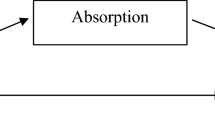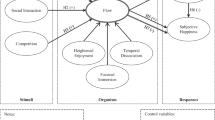Abstract
The trend of multimodal interaction in interactive gaming has grown significantly as demonstrated for example by the wide acceptance of the Wii Remote and the Kinect as tools not just for commercial games but for game research as well. Furthermore, using the player’s affective state as an additional input for game manipulation has opened the realm of affective gaming. In this paper, we analyzed the affective states of players prior to and after witnessing a scary event in a survival horror game. Player affect data were collected through our own affect annotation tool that allows the player to report his affect labels while watching his recorded gameplay and facial expressions. The affect data were then used for training prediction models with the player’s brainwave and heart rate signals, as well as keyboard–mouse activities collected during gameplay. Our results show that (i) players are likely to get more fearful of a scary event when they are in the suspense state and that (ii) heart rate is a good candidate for detecting player affect. Using our results, game designers can maximize the fear level of the player by slowly building tension until the suspense state and showing a scary event after that. We believe that this approach can be applied to the analyses of different sets of emotions in other games as well.





Similar content being viewed by others
Notes
While there are available labeling tools specific for the purpose, e.g., FEELTrace [30], we did not use such tools because they commonly play only one video at a time which requires an additional step of combining the videos before the annotation process.
In fact, the music is related to the chasing speed which is difficult for participants to observe as the Slender Man stops moving when participants look at it directly.
References
Dekker A, Champion E (2007) Please biofeed the zombies: enhancing the gameplay and display of a horror game using biofeedback. In: Proceedings of digital games research association (DiGRA) 2007 conference, pp 550–558
D’Mello S, Taylor R, Graesser A (2007) Monitoring affective trajectories during complex learning. In: Proceedings of the 29th annual conference of cognitive science society, pp 203–208
Drachen A, Nacke LE, Yannakakis G, Pedersen AL (2010) Correlation between heart rate, electrodermal activity and player experience in first-person shooter games. In: Proceedings of the 5th ACM SIGGRAPH symposium on video games, pp 49–54. doi:10.1145/1836135.1836143
Fanselow MS (1994) Neural organization of the defensive behavior system responsible for fear. Psychon Bull Rev 1(4):429–438. doi:10.3758/BF03210947
Garner T, Grimshaw M (2011) A climate of fear: considerations for designing a virtual acoustic ecology of fear. In: Proceedings of the 6th audio mostly—a conference on interaction with sound, pp 31–38. doi:10.1145/2095667.2095672
Garner T, Grimshaw M, Abdel Nabi D (2010) A preliminary experiment to assess the fear value of preselected sound parameters in a survival horror game. In: Proceedings of the 5th audio mostly—a conference on interaction with sound. doi:10.1145/1859799.1859809
Giakoumis D, Tzovaras D, Moustakas K, Hassapis G (2011) Automatic recognition of boredom in video games using novel biosignal moment-based features. IEEE Trans Affect Comput 2(3):119–133. doi:10.1109/T-AFFC.2011.4
Gilleade KM, Dix A, Allanson J (2005) Affective videogames and modes of affective gaming: assist me, challenge me, emote me. In: Proceedings of digital games research association (DiGRA) 2005 conference, pp 547–554
Hall M, Frank E, Holmes G, Pfahringer B, Reutemann P, Witten IH (2009) The weka data mining software: an update. SIGKDD Explor Newsl 11(1):10–18. doi:10.1145/1656274.1656278
Higuchi T (1988) Approach to an irregular time series on the basis of the fractal theory. Phys D 31(2):277–283. doi:10.1016/0167-2789(88)90081-4
Hudlicka E (2009) Affective game engines: motivation and requirements. In: Proceedings of the 4th international conference on foundations of digital games, pp 299–306. doi:10.1145/1536513.1536565
Jennett C, Cox AL, Cairns P, Dhoparee S, Epps A, Tijs T, Walton A (2008) Measuring and defining the experience of immersion in games. Int J Hum Comput Stud 66(9):641–661. doi:10.1016/j.ijhcs.2008.04.004
Khanna P, Sasikumar M (2010) Recognising emotions from keyboard stroke pattern. Int J Comput Appl 11(9):1–5. doi:10.5120/1614-2170
Krzywinska T (2002) Hands-on horror. Screenplay: cinema/videogames/interfaces. Wallflower Press, London, pp 206–223
Landwehr N, Hall M, Frank E (2005) Logistic model trees. Mach Learn 59(1–2):161–205
Lane JS (2012) The effect of performance experience on vocal music major’s perception of musical tension. J Res Music Perform. ISSN: 2326–1722
Laurans G, Desmet PM, Hekkert P (2012) Assessing emotion in human–product interaction: an overview of available methods and a new approach. Int J Prod Dev 16(3–4):225–242. doi:10.1504/IJPD.2012.049835
Mandryk RL, Atkins MS (2007) A fuzzy physiological approach for continuously modeling emotion during interaction with play technologies. Int J Hum Comput Stud 65(4):329–347. doi:10.1016/j.ijhcs.2006.11.011
Martinez HP, Garbarino M, Yannakakis GN (2011) Generic physiological features as predictors of player experience. In: Proceedings of the 4th international conference on affective computing and intelligent interaction, part I, pp 267–276
Metallinou A, Narayanan S (2013) Annotation and processing of continuous emotional attributes: challenges and opportunities. In: Proceedings of the 10th IEEE international conference and workshops on automatic face and gesture recognition. doi:10.1109/FG.2013.6553804
Nacke L, Lindley CA (2008) Flow and immersion in first-person shooters: measuring the player’s gameplay experience. In: Proceedings of the 2008 conference on future play, pp 81–88. doi:10.1145/1496984.1496998
Nacke LE, Kalyn M, Lough C, Mandryk RL (2011), Biofeedback game design: using direct and indirect physiological control to enhance game interaction. In: Proceedings of the SIGCHI conference on human factors in computing systems, pp 103–112. doi:10.1145/1978942.1978958
Öhman A (2007) Anxiety. Encyclopedia of stress, 2nd edn. Academic Press, New York, pp 236–239
Onyett C (2012) Slender is pure horror. http://www.ign.com/articles/2012/07/07/slender-is-pure-horror. Accessed 22 Jan 2014
Parker JR, Heerema J (2008) Audio interaction in computer mediated games. Int J Comput Games Technol 2008:178923. doi:10.1155/2008/178923
Perron B (2004) Sign of a threat: the effects of warning systems in survival horror games. In: Proceedings of the 4th international conference on computational semiotics, Split
Prieto-Pablos JA (1998) The paradox of suspense. Poetics 26(2):99–113. doi:10.1016/S0304-422X(98)00014-X
Quinlan JR (1993) C4.5: programs for machine learning. Morgan Kaufmann, San Francisco
Roux-Girard G (2011) Listening to fear: a study of sound in horror computer games. In: Grimshaw M (ed) Game sound technology and player interaction. IGI Global, Hershey, pp 192–212
Schröder M, Cowie R, Douglas-Cowie E, Savvidou S, McMahon E, Sawey M (2000) ’FEELTRACE’: an instrument for recording perceived emotion in real time. Proceedings of the ISCA workshop on speech and emotion. Textflow, Belfast, pp 19–24
Sourina O, Liu Y, Nguyen MK (2012) Real-time EEG-based emotion recognition for music therapy. J Multimodal User Interfaces 5(1–2):27–35. doi:10.1007/s12193-011-0080-6
Task Force of the European Society of Cardiology the North American Society of Pacing Electrophysiology (1996) Heart rate variability: standards of measurement, physiological interpretation, and clinical use. Circulation 93(5):1043–1065. doi:10.1161/01.CIR.93.5.1043
Toprac P, Abdel-Meguid A (2011) Causing fear, suspense, and anxiety using sound design in computer games. In: Grimshaw M (ed) Game sound technology and player interaction. IGI Global, Hershey, pp 176–191
Truong KP, Neerincx MA, van Leeuwen DA (2008) Assessing agreement of observer- and self-annotations in spontaneous multimodal emotion data. In: Proceedings of the 9th Annual Conference of the International Speech Communication Association, pp 318–321.
Tsui WH, Lee P, Hsiao TC (2013) The effect of emotion on keystroke: an experimental study using facial feedback hypothesis. In: Proceedings of the 35th annual international conference of the IEEE engineering in medicine and biology society, pp 2870–2873. doi:10.1109/EMBC.2013.6610139
Wang Q, Sourina O, Nguyen MK (2011) Fractal dimension based neurofeedback in serious games. Vis Comput 27(4):299–309. doi:10.1007/s00371-011-0551-5
Weber R, Behr KM, Tamborini R, Ritterfeld U, Mathiak K (2009) What do we really know about first-person-shooter games? An event-related, high-resolution content analysis. J Comput Mediat Commun 14(4):1016–1037. doi:10.1111/j.1083-6101.2009.01479.x
Witten IH, Frank E, Hall MA (2011) Data mining: practical machine learning tools and techniques, 3rd edn. Morgan Kaufmann, Amsterdam
Yannakakis GN, Hallam J (2008) Entertainment modeling through physiology in physical play. Int J Hum Comput Stud 66(10):741–755. doi:10.1016/j.ijhcs.2008.06.004
Acknowledgments
This work was partly supported by JSPS Core-to-Core Program, A. Advanced Research Networks.
Author information
Authors and Affiliations
Corresponding author
Rights and permissions
About this article
Cite this article
Vachiratamporn, V., Legaspi, R., Moriyama, K. et al. An analysis of player affect transitions in survival horror games. J Multimodal User Interfaces 9, 43–54 (2015). https://doi.org/10.1007/s12193-014-0153-4
Received:
Accepted:
Published:
Issue Date:
DOI: https://doi.org/10.1007/s12193-014-0153-4




